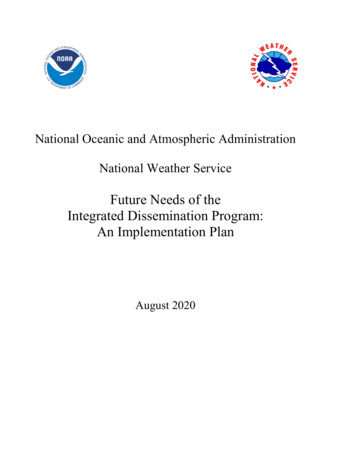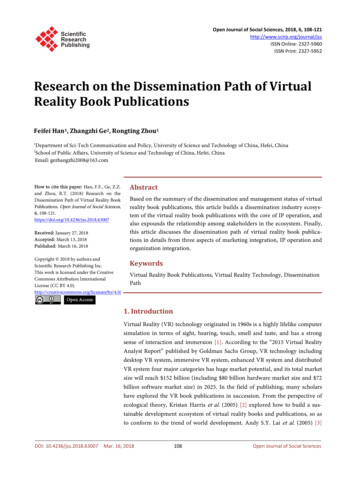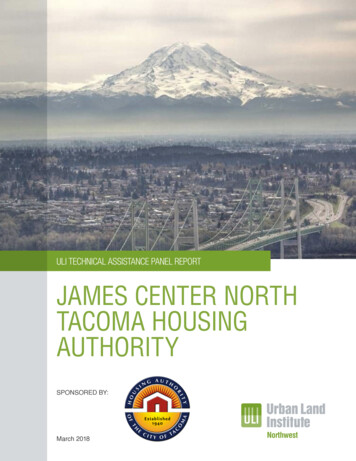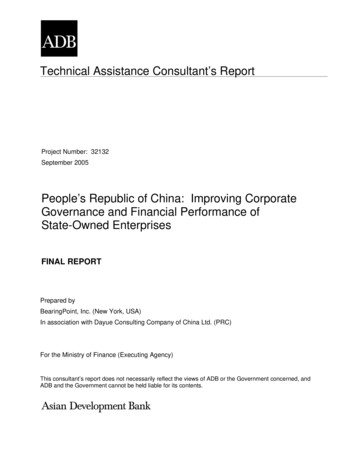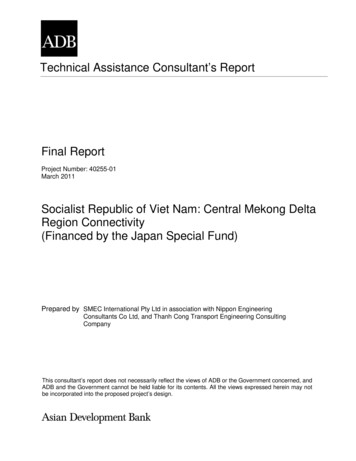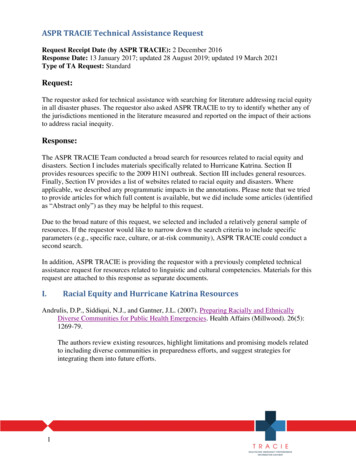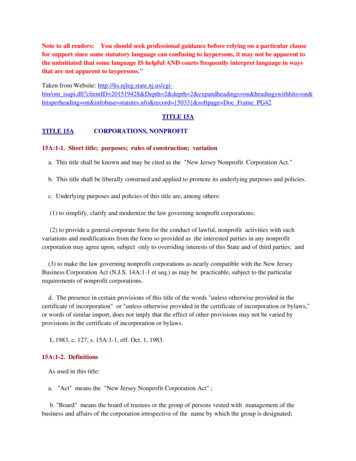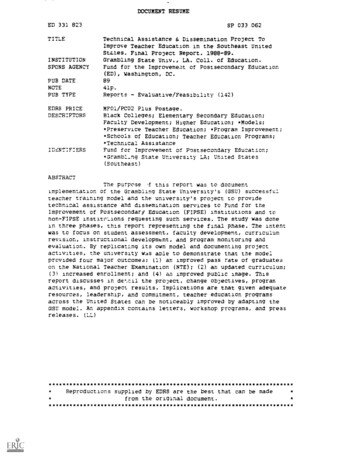
Transcription
DOCUMENT RESUMEED 331 823TITLESP 033 062Technical Assistance & Dissemination Project ToImprove Teacher Education in the Soutneast UnitedStittes. Final Project Report. 3.988-89.INSTITUTIONSPONS AGENCYGrambling State Univ., LA. Coll. of Education.Fund for the Improvemeat of Postsecondary Education(ED), Washington, DC.PUB DATENOTEPUB TYPE8941p.EDRS PRICEDESCRIPTORSMF01/PCO2 Plus Postage.Black Colleges; Elementary Secondary Education;Faculty Development; Higher Education; *Models;*Preservice Teacher Education; *Program Improvement;*Schools of Education; Teacher Education Programs;*Technical AssistanceFund for Improvement of Postsecondary Education;*Grambl ng State University LA; United StatesInt:NTIFIERSReports - Evaluative/Feasibility (142)(Southeast)ABSTRACTThe purpose 'f this report was to documentimplementation of the Grambling State University's (GSU) successfulteacher training model and the university's project to providetechnical assistance and dissemination services to Fund for tneImprovement of Postsecondary Education (FIPSE) institutions and tonon-FIPSE institinLions requesting such services. The study was donein three phases, this report representing the final phase. The intentwas to focus on student assessment, faculty development, curriculumrevision, instructional development, and program monitoring andevaluation. By replicating its own model and documenting projectactivities, the university wAs able to demonstrate that the modelprovided four major outcomes: (1) an improved pass rate of graduateson the National Teacher Examination (NTE); (2) an updated curriculum;(3) increased enrollment; and (4) an improved public image. Thisreport discusses in de*.oil the project, change objectives, programactivities, and project results. Implications are that given adequateresources, leadership, and commitment, teacher education programsacross the United States can be noticeably improved by adapting theGSU model. An appendix contains letters, workshop programs, and pressreleases. (LL)************************** ***** ********************* ***** * ***** ********Reproductions supplied by EDRS are the best that can be madefrom the original document.******* * ********* * *********** *********************** ****************** *
-werreU S DEPANTNIENT Of EDUCATIONCV,%.4 Eaucat.onfOSaemeek h and Irnpro,,eirentFEWCADCWAI. RESOURCES INFORMATIONCE NTE R a RIC)Pecument nes been feOPOOsved 13reoeree frorn the person of orgerrziebOnorgenet.ng 4t' PAnor changes have twer, made 10 wnre0ife,t p,CsduC fiat) guatli,po,ols co .4.* 6, oprmDas stated :n tf,15 doctrrtlerst 00 not nitCesSar0 rporesent off ecsalOFR' possUar% o poicy'glow
Grantee Organization:Grambling State UniversityCollege of EducationP. 0. Box 46Grambling, LA 71245Grant No.:G008642156Project Dates:Starting Date:Ending Date:Number of months:October 1, 1986September 30, 198936Project Director:Jo Ann DauzatP. O. Box 4293Grambling State UniversityGrambling, LA 71245Telephone (318) 274-2185FIPSE Program Officer(s):Diana HaymanGrant Award:Year 1Year 2Year 3Total 86,223 88,270 84.05 259428
1Project OverviewResponding to the nation's dilemma of how to improve the performanceof minority graduates on teacher competency tests, GSU implemented a projectto adapt its own Successful teacher training model for implementation by othersimilar institutions. The Technical Assistance and Dissemination Project toImprove Teacher Education is being implemented in three phases over a threeyear period. Phase III project activities yielded several significant outcomesincluding: 1) the development of computer disks for ehe NTE Specialty Area ofElementary Education; 2) the development of additional video tapes and otherresource materials for teacher education training purposes; 3) the productionand dissemination of a Project newsletter; 4) a one day conference in Anaheim,CA and a variety of workshops on the GSU campus; 5) continued disseminationof information regarding the Grambling teacher education model; and 6) thedissemination of the Professional Knowledge Computer disks to the FIPSEinstitutions and to non-FIPSE institutions requesting them.PurposeThe purpose of the Technical Assistance and Dissemination Project toImprove Teacher Education is to adapt GStls teacher training model byproviding technical assistance and dissemination services to three historicallyBlack institutions in the Southeastern United States who were experiencingproblems in their teacher training programs. The adaptation covers six programobjectives, spanning a three-year period, reflecting the components ofGrambling's model: 1) assessment of programmatic needs; 2) design anddevelopment of tailored program improvement plans; 3) curriculum reform; 4)faculty development; 5) academic intervention and accountability; and 6)academic monitoring of student performance. Additionally, Grarnbling desiresto provide other institutions with a forum for exchanging ideas and information,increased opportunities for cooperative problem solving, and increasedaccessibility to technical assistance and resource materials.
2Although much time and energy have gone into assessing the scope,magnitude and impact of teacher uaining and teacher testing problems,considerable confusion remains regarding possible solutions to theseproblems. Garibaldi (1986) summoned more research on the declining Blackteacher; Educational Testing Services (ETS), producers of the NTE, advisedthat predominantly Black institutions must improve the poor reading skills,analytical problem solving skills, and general knowledge deficiencies ofstudents; and some states (i.e. Alabama, Florida and Louisiana) have simplyimplemented competency laws which raise the entry requirements for teachertraining programs (AACTE Briefs, December 1981).Institutions suffering overwhelmingly poor student performance continueto search frantically for a solution. At best most of this action represents onlyscattered, unsystematic attempts to apply programmatic band aids. Continuedinadequate test performance is the result of these "piece meal" approaches.Colleges of Education (COE's) receive the most negative impact from testing fallout, they therefore must assume leadership for reform in teacher testing and thegeneral improvement of teacher education. All of the above suggestionsprobably have some degree of validity, but an effective comprehensiveimprovement strategy is needed. Grambling's model appears to offer asolution. The Technical Assistance and Dissemination Project representsGrambling's efforts to address this need.Background and OriginsGrambling State Unliversity is a small, rural, historically Black institutionlocated in North Central Louisiana. It is one of only two such Black publicinstitutions in the state. Open admission laws and Grambling's history of takingstudents where they are and transforming them into productive citizens haveattracted varied levels of students from across the nation. Primarily, though, thetypical freshman is a Black student suffering from previous economic,educational and social disadvantages.Of the institution's 6,534 students,approximately 90 percent receive some form of financial aid.
3Until recently Grambling was recognized nationally and internationallyprimarily for its football accomplishments and the band's high steppingperformances. During the early eighties, the University also became known forits court struggles with state and federal governments to advance equity forBlacks in higher education.Though less renowned, Grambling's teacher education program also hasa proud and illustrious history. The University began as a teacher trainingcollege. Through the years it has distinguished itself in the state as a leader indeveloping innovative teacher training models (Jeanes teachers, supervision offirst year teachers, the master teacher). Growth and progress prompted thedemise of Grarnbling as solely a teacher training institution, while at the sametime, transforming it into a comprehensive degree granting university. As aresult, the College of Education, with four departments, numerousundergraduate and graduate degree programs, and a K-12 laboratory schoolprogram, became one of several such organizeonal units.Seven years ago, Grambling suffered poor student performance onstandardized teacher competency tests. in response, the College of Educationmade a conscious choice to develop a program of excellence in teachereducation. The desire was to take the present program and make it better. Thenew program would reflect not only responsiveness to emergent societal forcessuch as teacher testing, but also responsiveness to changes in the knowledgebase for teacher education caused by societal manipulations and research.The past scores of Grambling's graduates on the National TeacherExaminations (NTE) suggested that students had acute knowledge and skilldeficiencies in several academic areas. Moreover, consistent publicity ofGrambling's high NTE failure rate in various newspapers nourished a negEtivepublic image of the Teacher Training Program. The implication of these reportswas that Grambling and other similarly troubled institutions were unaffordableacademic blights. The message of the time seemed to have been "We wantBlack teacher colleges out of business." Consequently, if Grambling were tocontinue helping to neet society's educational needs, and if the College wereto stay in business, student performance would have to improve.
4Ninety-eight percent of tad faculty in the College of Education haveterminal degrees representing some of the most prominent institutions inAmerica. Confrontation with troubled times, reforms, and the changes occurringin 1980 were nothing new to the education faculty. Historically, it had survivedmany similar adversities. Yet, because of poor student performance on theNational Teacher Examination (NTE), the faculty met public indictment withgreat trepidation. Failure rates of 80 to 90 percent for Grambling's graduates forinitial certification seemed to totally disarm faculty members. This was an affrontto their credibility.Most faculty saw the lack of supplies, equipment and travel monies as th,major problem. The poor performance of the students on the NTE seemed atfirst to be a secondary concern. Faculty also felt the NTE problem resulted fromthe poor scholastic quality of entering students and the failure of other academicunits to do their jobs. Central administration on the other hand, saw the primaryand foremost problem as that of the poor performance of the students on theNTE.They felt the situation could be made markedly better by improvingmanagement and faculty productivity within the College of Education.From all appearances in 1980, the College of Education and the othersupport units were in a heated battle against organizational inertia, especiallyas it related to education majors. A disappointing number of people seemedcontent with past accomplishments and complacent about the current state ofaffairs. They seemed unmoved by the fact that many things having impact uponteacher education were changing around them--that they too would need tochange if Grambling's COE were to regain its status as a leader and remaincurrent and responsive to dynamic societal demands.Initially, the Dean was faced with the challenge of influencing people atall levels to work with the College to make a difference in student performance.At least 70 percent of the academic preparation of teacher educationcandidates at Grambling is obtained through academic departments outside ofthe College of Education. It was, therefore, important to get the President, VicePresident, Deans, Department Heads and faculty in other colleges to accept thefact that the poor performance of teacher education students on the NTE was auniversity-wide problem and everyone must be accountable for planned
5improvement efforts. Other organizational needs included the following: 1)changing the College of Education from being a near-closed system to being asystem very much open to new ideas and guidance from outside its boundaries;2) offering renewal activities for tenured faculty members who were eitherburned out, unmotivated, or retired on the job; 3) reviving the College byintroducing innovations; 4) hiring, when possible, new faculty with new ideas; 5)freeing the faculty to say, 1 don't know," or "I need help"; 6) providing growthopportunities for tenured faculty motivated toward personal and professionaldevelopment goals and 7) providing daily guidance and leadership for facultymembers who demonstrated a lack of self-direction.During the eight years following Grambling's 1980 decision to pursueexcellence in teaching, the College of Education has witnessed thedevelopment of many innovative ideas, practices and products; none of whichcame easily. It has emerged from the struggles of change. Forces such aspersonnel changes, faculty perceived autonomy and course ownership, andresistance to changing encrusted traditional structures and behaviors frequentlyoperated to undermine improvement efforts. Ultimately, these forces weretransformed into constructive energy that netted the College many benefits.The Technical Assistance and Dissemination Projects did not requirechanges in GSU's organizational policy. Except for documentation, the Project,thus far, has not required any unusual activities for the faculty. Essentially theCollege's task was to continue implementing its model as it had been designed.Phase III activities were mainly conc. Pned with the dissemination of materialsproduced in the previous years, but there were also new materials produced.Phase HI activities includeddeveloping the first of a series of three computer disks on1)2)3)4)5)Elementary Education.producing a video tape on Test Awareness and a series onGSU's modelcontinuing the newsletterholding a conference and workshopsdisseminating Professional Knowledge computer disks.
6Project DescriptionOver the past several years those in the fields of education, research,testing, and local, state and federal politics have wrestled with the problemssurrounding teacher training, testing, and competency. While these problemshave plagued most post-secondary institutions to one degree or another,historically Black colleges and universities have suffered disproportionatelylower scores on teacher competency tests.It was concern for the plight of its teacher education programs and thethreatening extinction of Black and minority teachers that led Grambling StateUniversity to research, design, and validate an effective teacher trainingimprovement strategy. Due to the success of Grambling's strategy, as well asnational recognition and requests for assistance from other institutions,Grambling undertouk the challenge of a teacher training Project that wouldprovide technical assistance and dissemination services to the institutionsmentioned earlier.Besides Project institutions receiving benefits, the network of schools towhich they belong also benefit. A pyramid or ripple effect in sharing occurs.Final Project outcomes will include: increased faculty accountability forinstruction in general, specialized, and professional education courses;increased acceptance of responsibility by liberal arts faculties for studentperformance; increased student mastery of general, professional, andspecialized knowledge; improved performance standards for students;improved student performance on standardized competency tests for initialteacher certification; and stronger teacher education programs in general.Ultimately, this project will contribute to the survival of historically Blackinstitutions and serve as a national model for improving teacher trainingprograms through cooperative efforts.Technical assistance is provided by Grambling's education faculty and ateam of external consultants. Dissemination of diverse training materials andrelated information support Grambling's technical assistance efforts. Assistanceis tailored to the needs, capacity, and fiscal commitment of project institutions.Unique Project features include: (a) opportunities for institutional sharing and
7collective problem solving; (b) organizational development; (c) continuousdocumentation, assessment, feedback and evaluation activities: and (d)opportunities to foster peer relationships among faculty members with similarresponsibilities at involved institutions.The Grambling State University Technical Assistance and DisseminationProject is being implemented in three phases over a three-year period. Thefocus for each of the three phases is described on pages 15-17 in the originalapplication. Grambling has been involved in Phase Ill of project activities withSeptember 30, 1989 marking the end of the third phase.Phase Ill activities have centered around the dissemination of materialproduced in Phase II and continuing workshops and material development.Specifically, these activities included sponsoring several workshops for facultymembers and teacher education students, producing of a set of video tapes forinclusion in the project Resource Bank, and developing or securing otheradditional Resource Bank materials. Information regarding these activities isincluded in the appendix.The Phase III activities included:1.developing the first computer disk for the NTE Specialty areaof Elementary Education. This disk contains 100 NTE-likequestions divided into 10 topic areas.2.developing a video tape dealing with test awareness relatingto the NTE. This video explains the Core Battery and showshow to make the most of the time given as well as generaltest tal.:ng tips.3.continuing production and dissemination of the Projectnewsletter.4.holding a one day conference in Anaheim, CA.The topicspresented by FIPSE schools were "Closing the Gap inMinority Teacher Testing: University-wide and Unit ActionStrategies," "Testing as a Teaching Strategy," "GramblingState University Improvement Model,* and "Responses for theFuture."5.holding various workshops on the Grambling campus,including:a)"Current Trends in Instructional Technology and Design"with Dr. Waft Wager;I"
8b)"The Use of Technology in Instruction* with Drs.Elizabeth Goldman and Robert Sherwood;c)"Technology and Thinking, Learning, and Study Skills:What is the Status?"' with Dr. Bennie Lowery;6.arranged an ofl-site visit by Dr. Ila Dive of Virginia State7.disseminating the Professional Knowledge computer disks tothe other FIPSE institutions and non-FIPSE institutions whorequested them8.collecting data from the other FIPSE institutions regardingteacher certification goals as translated by Jack Gant9.developing a series of video tapes on GSU's model forTeacher Education.Consistent with the overall Project goals presented in the originalapplication, specific outcomes will be of a quantitative and qualitative nature.The major outcomes of both categories follow.Quantitative OutcomesQuantitative results reflect an increase In:the percent of students at Project Institutions passing the NTEthe percent of students at Project Institutions passing the requiredexam for admission to the teaching programthe percent of involvement from campus-wide faculty at ProjectInstitutionsthe percent of participation in faculty development activitiesat Project Institutionsthe percent of students at Project Institutions passing both theCommunication Skills Module and the General KnowledgeModule of the NTE
9Qualitative OutcomesQualitative results reflect:*Commitment to and support for the improvement of teachereducation programs at Project Institutions*More successful student performance due to modificationsin the teacher-training curriculum at Project Institutions*Increased administrative support for the improvement ofteacher education at Project Institutions«Stronger desire to upgrade student skills via the curriculumat Project InstitutionsInstructional strategies that are more effective at ProjectInstitutions.Problems Faced During P
undergraduate and graduate degree programs, and a K-12 laboratory school program, became one of several such organizeonal units. Seven years ago, Grambling suffered poor student performance on. standardized teacher competency tests. in response, the College of Education. made a conscious choice to develop a program of excellence in teacher .
